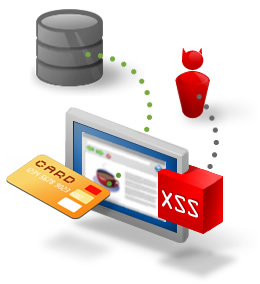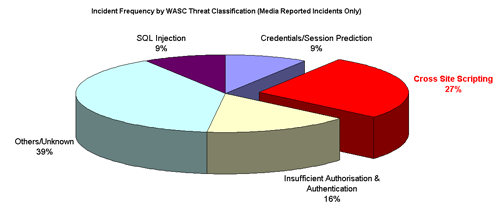
What is Cross site Scripting?
Cross Site Scripting (also known as XSS or CSS) is generally believed to be one of the most common application layer hacking techniques.

Today, websites rely heavily on complex web applications to deliver different output or content to a wide variety of users according to set preferences and specific needs. This arms organizations with the ability to provide better value to their customers and prospects. However, dynamic websites suffer from serious vulnerabilities rendering organizations helpless and prone to cross site scripting attacks on their data.
"A web page contains both text and HTML markup that is generated by the server and interpreted by the client browser. Web sites that generate only static pages are able to have full control over how the browser interprets these pages. Web sites that generate dynamic pages do not have complete control over how their outputs are interpreted by the client. The heart of the issue is that if mistrusted content can be introduced into a dynamic page, neither the web site nor the client has enough information to recognize that this has happened and take protective actions." (CERT Coordination Center).
Cross Site Scripting allows an attacker to embed malicious JavaScript, VBScript, ActiveX, HTML, or Flash into a vulnerable dynamic page to fool the user, executing the script on his machine in order to gather data. The use of XSS might compromise private information, manipulate or steal cookies, create requests that can be mistaken for those of a valid user, or execute malicious code on the end-user systems. The data is usually formatted as a hyperlink containing malicious content and which is distributed over any possible means on the internet.
Any web page which passes parameters to a database can be vulnerable to this hacking technique. Usually these are present in Login forms, Forgot Password forms, etc…
N.B. Often people refer to Cross Site Scripting as CSS or XSS, which is can be confused with Cascading Style Sheets (CSS).
Is your site Vulnerable to Cross Site Scripting
Our experience leads us to conclude that the cross-site scripting vulnerability is one of the most highly widespread flaw on the Internet and will occur anywhere a web application uses input from a user in the output it generates without validating it. Our own research shows that over a third of the organizations applying for our free audit service are vulnerable to Cross Site Scripting. And the trend is upward.
Example of a Cross Site Scripting attack
As a simple example, imagine a search engine site which is open to an XSS attack. The query screen of the search engine is a simple single field form with a submit button. Whereas the results page, displays both the matched results and the text you are looking for.
Example:
Search Results for "XSS Vulnerability"
To be able to bookmark pages, search engines generally leave the entered variables in the URL address. In this case the URL would look like:
http://test.searchengine.com/search.php?q=XSS%20
Vulnerability
Next we try to send the following query to the search engine:
<script type="text/javascript"> alert('This is an XSS Vulnerability') </script>
By submitting the query to search.php, it is encoded and the resulting URL would be something like:
http://test.searchengine.com/search.php?q=%3Cscript%3
Ealert%28%91This%20is%20an%20XSS%20Vulnerability%92%29%3C%2Fscript%3E
Upon loading the results page, the test search engine would probably display no results for the search but it will display a JavaScript alert which was injected into the page by using the XSS vulnerability.
How to check for Cross site scripting vulnerabilities
To check for Cross site scripting vulnerabilities, use a Web Vulnerability Scanner. A Web Vulnerability Scanner crawls your entire website and automatically checks for Cross Site Scripting vulnerabilities. It will indicate which URLs/scripts are vulnerable to these attacks so that you can fix the vulnerability easily. Besides Cross site scripting vulnerabilities a web application scanner will also check for SQL injection & other web vulnerabilities.
Preventing Cross Site Scripting attacks
To prevent these attacks, dangerous characters must be filtered out from the web application inputs. These should be filtered out both in their ASCII and HEX values.
For The Xss Cross SIte Scripting Scripts Click Here






